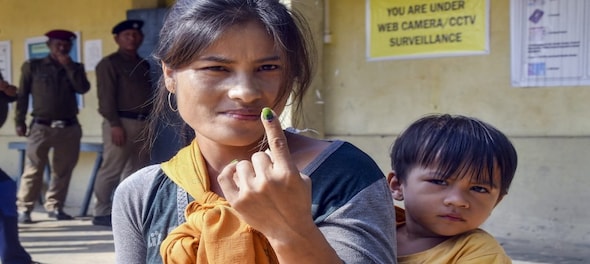
Elections to the five state assemblies got off to a start on Tuesday with voters in Mizoram and 20 constituencies in Chhattisgarh deciding which party or formation should govern them.
In Mizoram, where the polling concluded for all the 40 seats in a single phase, the approximate turnout touched nearly 76% while in Chhattisgarh it was a shade under 71%. Though the number of voters who turned out to cast their votes in Mizoram was impressive, percentage wise it was a bit lower compared to 2018 election as it stood at 81.61% then. However, the final figures for yesterday's polls should be more in the final count.
Besides strong local issues, the turnout should also be viewed in the backdrop of a massive campaign by the Election Commission of India to encourage people to come out and vote. It also took a series of steps to encourage greater participation by the young, first time voters as well as super senior citizens, offering them to participate from the comfort of their home.
Mizoram
Political tussle for securing the right to form the government in Mizoram saw five parties in the fray. The Mizo National Front (MNF), which hopes to secure a mandate to govern for another term, another regional challenger Zoram Peoples Movement (ZPM) and three national parties, the Indian National Congress, the Bharatiya Janata Party and the Aam Aadmi Party.
From all accounts the two regional outfits, incumbent MNF and ZPM are considered the front runners. Interestingly, the MNF despite being an ally of the Bharatiya Janata Party-led National Democratic Alliance, preferred to go it alone. The embers of the unrest and violence in Manipur cast a shadow on the equations with Chief Minister Zoramthanga articulating views of not preferring to share a stage with BJP leadership.
The state also provided refuge to several thousand people who crossed over from Manipur, a development that gave the MNF an opportunity to battle the anti-incumbency factor. The party is also hoping to ward off the strong challenge from the other regional party, which gained ground in the urban areas. In 2018 the ZPM secured nearly 23 percent vote share and eight seats while the MNF with 37 per cent vote share had a bulk of 26 seats.
The Congress party, which like the MNF and ZPM is contesting all 40 seats, amid soaring hope that the people would vote to hand over the reins of government to the party instead of the two regional players, with close links with the BJP. The BJP contested on 23 seats and AAP on four seats with 27 Independents too in the fray.
Traditional calculations suggest a high turnout should mean voters' unhappiness with the incumbent government even as pre-poll surveys called MNF as the victor, with a reduced vote share and slender majority. Wait till December 3 when the EVMs spout the results out.
Chhattisgarh
In Chhattisgarh, the Election Commission decided to conclude polling in 20 seats, in areas where the threat of Naxals existed, in the first phase. In fact, there are reports from the state of Naxal attacks during the polling resulting in casualties among security forces.
The race here is essentially between the Congress party and the Bharatiya Janata Party. Even though he has not been projected, Chief Minister Bhupesh Baghel is banking on the work of his government during the past five years and steer the party back in the saddle. Of the 20 seats, the Congress represents 19 and is now banking to add the votes of Other Backward Classes (OBCs) in largely tribal dominated constituencies.
With Rahul Gandhi raising the stakes by campaigning for caste census to determine affirmative action, and the Congress promising it in the manifesto, the BJP has found itself on a backfoot. This is because the party has not formulated its clear stand even as its leadership sought to criticise the Congress by raking up the issue, which it called divisive.
The BJP, which prides in having a number of OBC leaders among its ranks, has held a series of meetings within and with its ideological mentor— the RSS leadership — on the issue. The closest, BJP came was when Home Minister Amit Shah said the party was not opposed to it.
Tuesday’s polling also sealed the electoral fate of former BJP Chief Minister Raman Singh, who contested from his Rajnandgaon seat. The grip of Raman Singh, who was in office for three straight terms, on the electorate is however not the same after the 2018 debacle. The BJP too struggled to bring forward the next line of leadership and decided to field four sitting MPs to test the waters in the assembly.
Considering that last time the overall voter turnout was slightly over 76%, the current approximate for 20 seats can be extrapolated to be more or less equal, meaning that parties with better mobilisation would get added advantage when the votes are counted.
— The author, K V Prasad, is a senior journalist and has earlier worked with The Hindu and The Tribune. Views expressed are personal.
Read his previous articles here
(Edited by : C H Unnikrishnan)
First Published: Nov 8, 2023 9:10 AM IST
Check out our in-depth Market Coverage, Business News & get real-time Stock Market Updates on CNBC-TV18. Also, Watch our channels CNBC-TV18, CNBC Awaaz and CNBC Bajar Live on-the-go!


Supreme Court dismisses plea seeking postponement of CA exams; details here
Apr 29, 2024 2:29 PM
Just 8% women candidates contested first two phases of Lok Sabha polls
Apr 29, 2024 12:00 PM
The sexual assault case against Prajwal Revanna — here's what we know so far
Apr 29, 2024 11:36 AM
Repolling underway at one polling booth in Chamarajanagar LS segment in Karnataka
Apr 29, 2024 10:32 AM

